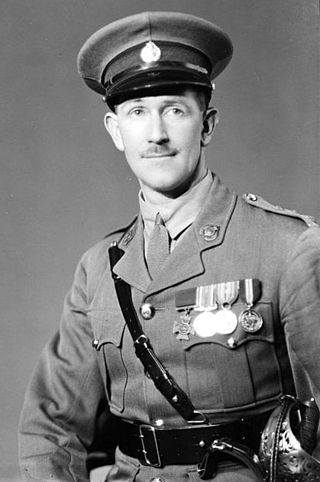
Brigadier Leslie Wilton Andrew, was a senior officer in the New Zealand Military Forces and a recipient of the Victoria Cross, the highest award of the British Commonwealth for gallantry "in the face of the enemy". He received the decoration for his actions during the Battle of Passchendaele in 1917.

The New Zealand Expeditionary Force (NZEF) was the title of the military forces sent from New Zealand to fight alongside other British Empire and Dominion troops during World War I (1914–1918) and World War II (1939–1945). Ultimately, the NZEF of World War I became known as the First New Zealand Expeditionary Force. The NZEF of World War II was known as the Second New Zealand Expeditionary Force (2NZEF).
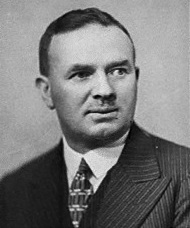
Brigadier James Hargest, was an officer of the New Zealand Military Forces, serving in both the First and Second World Wars. He was a Member of New Zealand's Parliament from 1931 to 1944, representing firstly the Invercargill and then the Awarua electorates.

The 23rd Infantry Brigade was an infantry brigade of the British Army that saw active service in the First World War, mainly on the Western Front During the Second World War, the brigade saw active service in the Syria-Lebanon Campaign, the Western Desert Campaign, and the Burma Campaign.
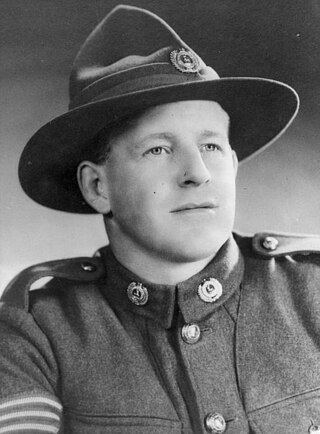
Alfred Clive Hulme VC was a soldier in the New Zealand Military Forces and a recipient of the Victoria Cross (VC), the highest award of the British Commonwealth, for gallantry "in the face of the enemy". He received the VC for his actions in the Battle of Crete during the Second World War.

The 27th Machine-Gun Battalion was a unit of the 2nd New Zealand Division during the Second World War. It served in the Greek Campaign, Western Desert Campaign, Tunisian Campaign, Italian Campaign and after the war took part in the Occupation of Japan. It was one of two New Zealand formations that served overseas longer than any other unit in the New Zealand Expeditionary Force. The battalion was also one of the New Zealand units that supplied men for the Long Range Desert Group.

Major General Graham Beresford Parkinson, was a professional soldier in the New Zealand Military Forces who served during the First and Second World Wars.
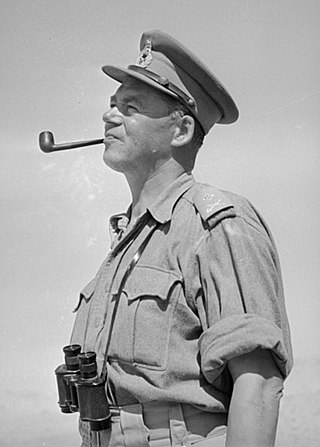
Major-General Lindsay Merritt Inglis, was a New Zealand military officer, lawyer and magistrate. Born in Mosgiel, he volunteered for service in the New Zealand Expeditionary Force during World War I. Inglis served on the Western Front and was awarded the Military Cross for his actions during the Battle of Flers-Courcelette. He ended the war as a company commander and returned to New Zealand in 1919.
The 21st Battalion was an infantry battalion of the New Zealand Military Forces that served during the Second World War. Formed in January 1940, it was part of the 5th Brigade, 2nd New Zealand Division of the 2nd New Zealand Expeditionary Force. The battalion saw action in Greece, Crete, North Africa and Italy before it was disbanded in December 1945.

The 20th Battalion was a formation of the New Zealand Military Forces which served, initially as an infantry battalion and then as an armoured regiment, during the Second World War as part of the 2nd New Zealand Division.
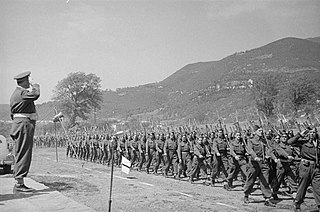
The 5th Infantry Brigade was an infantry brigade formation of the New Zealand Military Forces, active during World War II as part of the 2nd New Zealand Division. It saw service during the Battle of Greece, the Battle of Crete, the North African Campaign and the Italian Campaign before being disbanded in late 1945.

The 19th Battalion was a formation of the New Zealand Military Forces which served, initially as an infantry battalion and then as an armoured regiment, during the Second World War as part of the 2nd New Zealand Division.

The 18th Battalion was a formation of the New Zealand Military Forces which served, initially as an infantry battalion and then as an armoured regiment, during the Second World War as part of the 2nd New Zealand Division.

The 24th Auckland Battalion was an infantry battalion of the New Zealand Army during the Second World War. The 24th Battalion was formed on 1 February 1940 and embarked for Egypt on 28 October 1940. It was part of the 6th Infantry Brigade, part of the 2nd New Zealand Division. The battalion fought in Greece, North Africa and Italy. After the conclusion of hostilities, the battalion was disbanded in December 1945.

The 25th Battalion was an infantry battalion of the New Zealand Military Forces, which served during the Second World War as part of the 6th Infantry Brigade, 2nd New Zealand Division.
The 26th Battalion was an infantry battalion of the New Zealand Military Forces, which served during the Second World War as part of the New Zealand 2nd Division. Raised in May 1940, it fought in the Battle of Greece, the North African Campaign and the Italian Campaign. It finished the war in Trieste and was disbanded in December 1945.

The 30th Battalion was an infantry battalion of the New Zealand 3rd Division, raised for service during the Second World War. After being raised in late 1940, the battalion undertook garrison duties in Fiji and on New Caledonia during the early part of the war, before undertaking combat operations during the latter part of the Solomon Islands campaign, landing on Vella Lavella and the Green Islands in 1943–1944. The battalion was disbanded in mid-1944 to return manpower to the New Zealand economy and to provide reinforcements to the New Zealand 2nd Division, which was fighting in Italy.

Brigadier George Herbert Clifton, was a senior officer in the New Zealand Military Forces and a three-time recipient of the Distinguished Service Order.

The German invasion of Greece on 6 April 1941, had already been anticipated by the Allied forces. So a defense line was created across the mountain passes near Mount Olympus consisting of British, Australian and New Zealand troops which would prevend the German forces from capturing Thessaly and thereby denying them the opportunity to advance into mainland Greece. However, the speed of the German invasion force had made sure that the endurance of the defending troops and the strength of their defences were very quickly going to be put to the test.

Angus Ross was a New Zealand historian with a particular interest in the history and development of New Zealand's foreign policy. He was a professor of history at the University of Otago from 1965 until his retirement in 1976.

















